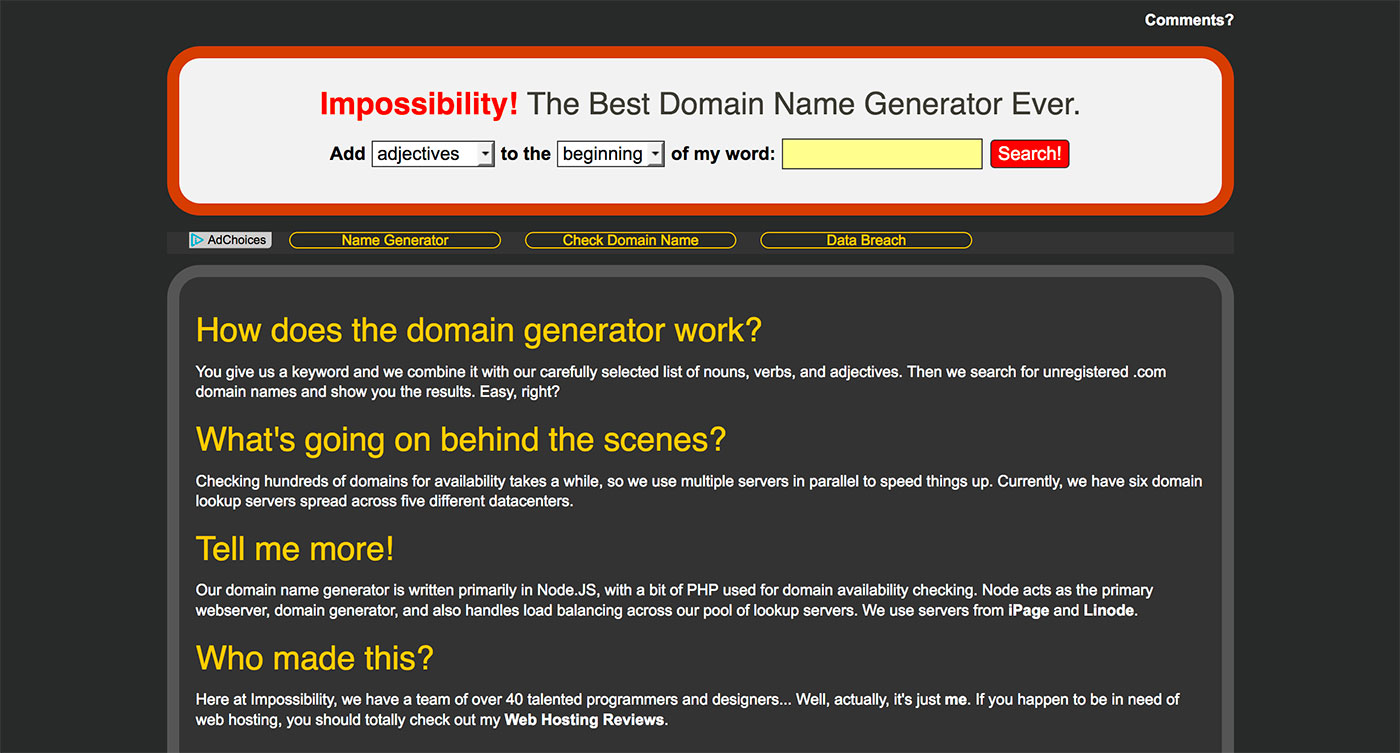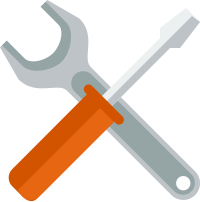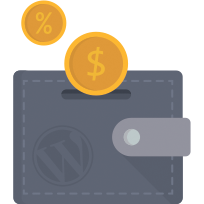
How to Choose a Great Domain Name for a Website?!
How do you find the perfect domain name for your website? How do you avoid making the common (and less common) mistakes that can come with domain ownership? To help you choose the best name possible for your site, this guide will walk you through the dos and dont's of the entire process -- from the very basics right through to finding the right name and registering it. (Note: For more guides in the same series, take a look at the WinningWP Guides page.)
-Note: WinningWP content is free to all. If you make a purchase through referral links on our site, we earn a commission (learn more).
Choosing a domain name is, without doubt, one of the most important things you'll need to do when starting a new website. For most sites, the domain name will also be the actual name of your site — it's the text visitors will type into their browser to access it, and one of the first things they'll see when they search for your site in Google.
This is a task that requires serious thought. Choose the right domain name and you’ll be a significant step closer to building a successful website/business; make the wrong choice, and you’ll face a multitude of difficulties later on — ranging from rebranding to stalled growth to a general lack of search engine traffic.
It’s vital you get this right!
Below, we'll run through everything you need to know to choose a great domain name. We’ll start off with the very basics, look at how to choose the right name (and what makes a great domain name), and then discuss some of the technical details for purchasing, registering and setting things up for success.
What Is a Domain Name?
The simple explanation behind domain names is that they are website addresses. google.com or winningwp.com, for example, are domain names. The technical explanation, however, is that domains are used to identify one or more IP addresses, which typically host websites.
Domain names are different from website hosting in that they only point web browsers to the location of the website. Hosting ensures there’s something available when a browser arrives at where it thinks the website should be.
Domain names consist of a string of characters followed by a dot and an extension (they're also preceded by either http:// or https://, but you can ignore this — for now).
The string of characters (for ease, we’ll call this the 'name') can only consist of letters, numbers and/or dashes -- other characters (i.e., :, $, #, @ , and so on) are not allowed. Names aren't case sensitive and they can't have spaces.
The domain extension denotes the type of organization running the website, with .com for commercial website, .org for non-profits, .gov for government entities, .edu for educational institutions and so on. Country-specific extensions, such as .co.uk. or .com.au, are also available, but, in practice, the vast majority of websites now use .com. We’ll talk more about extensions and which one is right for your site later on.
You register a domain name with a registrar -- a company that sells access to the central domain registry. The central registry is administered by a group called ICANN, who act as the quasi-police force for all domain registrations. There are hundreds of domain registrars available, and prices vary between them and per extension, but for a new .com, .net or .org domain, you can expect to pay around $10 a year. In contrast, a trendy .io domain will cost $30 a year, and a niche .movie domain will cost $250 a year. We’ll look at registrars and how to register a domain in more detail later on in this guide.
Each domain can only be registered once, so once a domain is registered it's unavailable until the owner opts to cease renewal of the registration. Note that registering the name with one extension (such as winningwp.com) does not entitle you to the same name with other extensions (such as winningwp.co.uk) -- these need to be registered separately. We’ll look at this issue, and also which extensions you should register, later on in this guide.
These are your domain name basics. With these covered, we can look at what your domain name should be.
What Should My Domain Name Be?
This is the primary question we’ll be helping you to answer with this guide. We’ve established that your domain is the gateway to your website, and highlighted the importance of making the right choice and finding a great domain name nobody else has registered.
Unfortunately, the task of choosing a domain name is made more difficult by the fact that most of the obvious domain names are already registered. At the time of writing, there were over 200,000,000 domains registered. Consider that there are fewer than 200,000 words in the dictionary, and you can see the extent to which obvious domain names are taken.
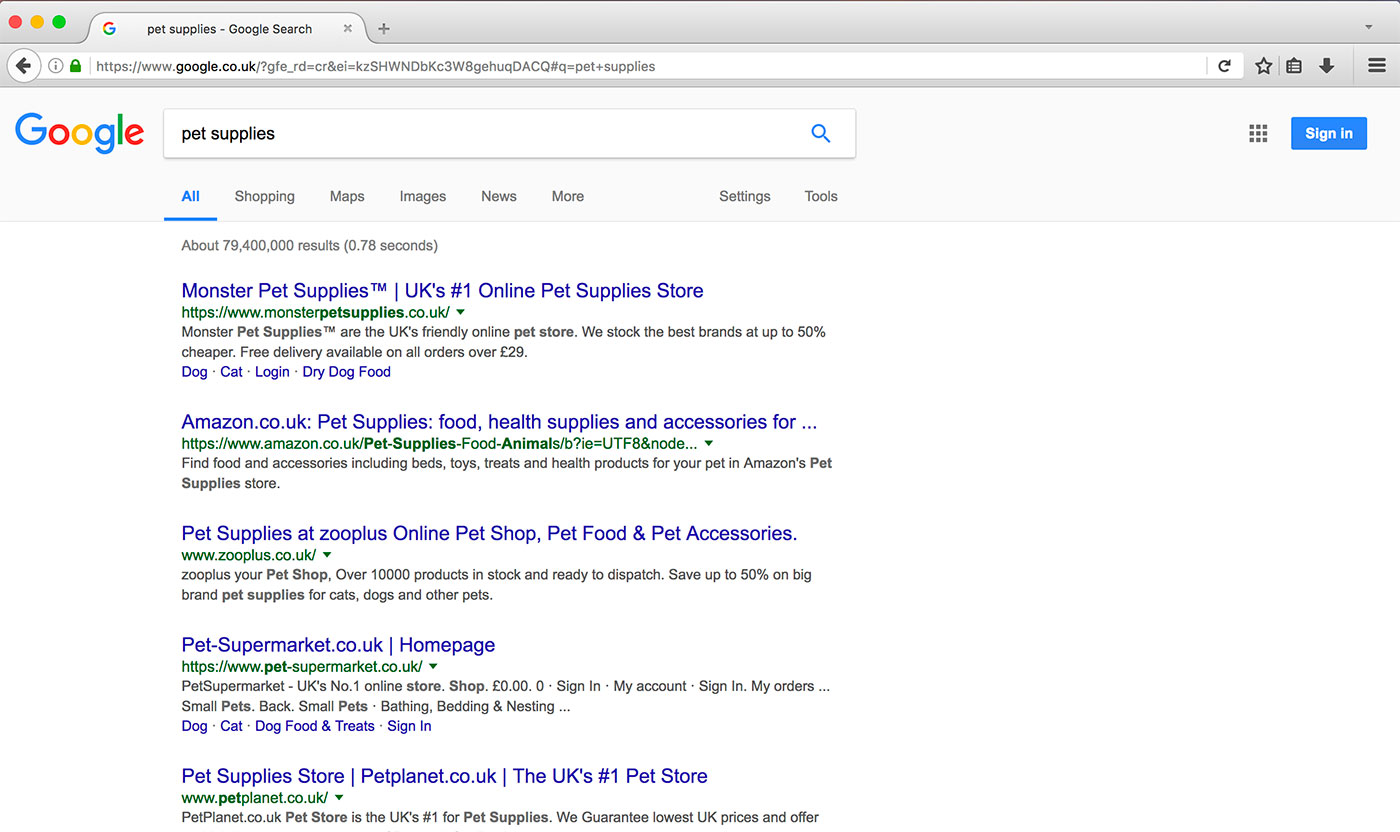
This isn’t necessarily a problem, though. To illustrate, imagine you want to purchase pet supplies. You’d most likely search pet supplies and click on one of the first results, regardless of the domain name, rather than visiting pets.com. This is because most domains are brandable (such as zooplus.com) rather than discoverable (such as pets.com). Users are used to typing unusual words such as google, etsy or flickr, rather than searchengine.com or internetmarketplace.com, so don’t worry that most discoverable domains are unavailable -- it just means you need to think slightly more creatively.
As virtually all dictionary words are already registered as domains, choosing a great domain name means choosing a great brandable domain name. We’ll first show you the rules for choosing any domain name and how to find ideas for your domain, and then discuss which extension you should be using.
It's possible to purchase domain names other people have already registered, but this can be very expensive and, for most people, it’s best to register a new domain from scratch. However, if you’re set on a specific domain that’s already registered, you may have no other option. We’ll cover this in detail later on in the guide.
The Rules for Choosing a Domain Name
We know it’s best for most people to register a new domain name from scratch. Before you start coming up with ideas, though, let’s cover some of the rules for choosing a domain name, so you can avoid making any embarrassing or legal mistakes.
The most important rule for choosing a great domain name relates to branding.
Your domain must be brandable. Branding is crucial to the long-term success of your website! This breaks down into three points: Your domain should sound like a brand, be intuitively easy to understand and be memorable.
You want to be able to establish a brand with your name that keeps visitors remembering your site and coming back for more. As you're coming up with ideas later, the test for this is easy: Does a given name sound like a brand? If yes, you've made a good start.
Simply coming up with a brandable name is insufficient, however: Visitors should also be able to see your domain name and straight away make an intuitive guess at what your site does or offers. This means your domain needs to offer some clue as to what your website is about. This site (winningwp.com) offers a great case study for this: The alliteration brings a brandable 'ring' to the name, but you can also immediately see the site is about bringing success with WordPress.
A certain level of originality is important, too, as your domain needs to be clearly memorable. You don’t want any confusion between your domain and others, so make sure your domain is unique. A quick Google search for your domain name idea will show you if anybody else is using the idea already. If there are similar or competing domains out there already, you've found one to avoid.
Fitting all three of these branding criteria is hard, but it's imperative for choosing a great domain name. We'll look at some tools you can use to help with this later on in the guide.
Branding is the most important rule, but there are also plenty of others. Below you'll find 11 shorter, but nonetheless important, rules for choosing a great domain name:
- Your domain should be available. Ideally, this means nobody else has registered it. You can check this at namecheap.com. As mentioned, it's possible to purchase domain names other people have purchased, but we’ll talk about this in more detail later on.
- Your domain should be short. The most popular domain name length is 11 characters, but the most popular websites in the world have an average of only six characters. Obviously, choosing a six-character domain is insufficient for making a popular website, but you can see shorter domains are better domains. Try for 11 characters or fewer.
- Search engines should like your domain name. What keywords are people going to search for to find your site? Consider including some of these in your domain name, and you’ll get a small boost in search engine rankings. It’s important, however, to get the balance right: A domain of only keywords (known as an 'Exact Match Domain') leaves you with limited branding options and looks spammy. Strongly consider including only one or two of the most relevant keywords in your domain name (
winningwp.com, for example, includes wp to denote WordPress). - Your domain should not use the definite article. Avoid the, at least as the first word in a domain. All this does is add length to your domain without adding value (as we know, shorter domains are better). Facebook was originally
thefacebook.com, but changed its name because 'it’s cleaner', following a famous conversation. Avoid the need to switch by avoiding the definite article in your domains in the first place. - Your domain should not include any characters other than letters. Domains can include hyphens and numbers, but this isn't advisable. Visitors won’t know if these should be spelled out or written using characters. You don’t want to be telling people your website is '
twentyfoursevenautorepair.comwith the numbers all spelled out' for as long as you have the site online. - Your domain should be spellable. If you’re using 'web 2.0' phrasing that involves removing a letter from a word such as Tumblr or Flickr, for example, do you need to also purchase the spelled-out version of the name? Flicker.com received over two million visitors a year who were expecting to visit Flickr.com, and it took Yahoo hundreds of thousands of dollars to acquire the former. You can avoid all of this by making sure your domain is spellable.
- Your domain should be pronounceable. Similarly, visitors need to be able to pronounce your domain name. Processing fluency refers to the cognitive bias humans have towards things that are pronounceable. Thus, a pronounceable domain name can be more easily remembered -- and a domain that more visitors remember is a better domain. This means you need to avoid any words or combination of words with ambiguous or difficult pronunciation. The test for this is easy: Can you say the name out loud? Is it easy? Make sure it is.
- Your domain should be future-proof. Will this still look good in ten years? Are you surfing current trends, or is your name timeless? Choose a domain that looks dated in a couple of years, and you’ll be forced to buy a new name and change your branding, confusing your visitors in the process. It's much better to choose a future-proof domain from the outset.
- Your domain should not infringe trademarks: Avoid legal trouble! If your domain uses, even in part, somebody else's trademark, they can bring expensive legal proceedings to take the domain off you. Use this tool to check domain name ideas against a trademark database (This site is
winningwp.comrather thanwinningwordpress.comto avoid infringing the WordPress trademark). Note, however, simply avoiding trademarks isn't necessarily enough: If you're in the same industry as the trademark owner and your domain is plausibly confusing (remember: It'd be a judge deciding this, not you), this can still be enough to cause a trademark infringement. Speak to a legal professional if you're unsure. - Your domain should not be an innuendo! Say your proposed name out loud and also check to see if it can spell any other words. This can be very embarrassing, so make sure to check.
- Your domain should not have bad history. Someone else may have owned your domain in the past. This isn’t necessarily bad, but it needs to be checked out. Type your proposed name into Archive.org to see if a site existed at your domain in the past. If it did, make sure the site was above board by using the archive to check its content and then check with Google to ensure the site was not marked as spam. You can also use Majestic to see which sites linked to the domain. Do your due diligence here, but for the vast majority of domains there won't be a problem.
There’s a lot to these rules, and they may look daunting, but consider them a checklist to work through when we get to coming up with domain name ideas. Check your domain idea against the rules, and if it passes you’ve got a winner!
We can now look in more detail at choosing the right extension, and then we'll cover how to come up with great domain name ideas.
Choosing the Right Extension
Before we look at how to find great domain name ideas (we’ll get there next, but it’s vital to understand the prerequisites), let’s talk more about choosing the right domain extension.
The rule for the vast majority of websites is simple: Always take the .com.
This is by far the most popular domain extension, with 75% of domains ending in .com. The prevalence of the .com means visitors expect to see it at the end of your domain, and they may end up at a competitor’s site if you’re not using it.
The main exception for when it’s best to choose an alternative to .com is country-specific extensions, such as .co.uk, .de or .com.au. If you’re sure you’ll only want to market in one country, this can be a useful way of establishing added trust with visitors, but make sure to also purchase the .com and redirect this to the country-specific domain. This will ensure you pick up all the traffic intended for your domain, and will give you the option of 'going global' later. Note also that you can tell Google which country your domain is targeted at, regardless of its extension.
If the .com isn’t available for the name you want, you'll almost certainly want to find a different name, rather than opt for an alternative extension such as .net or .org. If you absolutely can’t compromise on the name, then you’ll either want to purchase the domain (we'll get to this later) or choose an alternative domain extension. In recent years, hundreds of new extensions have been made available, ranging from .io, .me and .co to .blog, .website and .rocks, in addition to the more traditional alternative extensions such as .net and .org.
Using an alternative extension can let you get hold of a specific domain that isn’t otherwise available, and can lend your domain a quirky or trendy feel -- .io domains, for example, are popular with tech startups. Be aware, however, that everything we’ve discussed previously still stands: For most sites, the .com is best. The exception here is .org: It’s well established that non-profits can and should use this extension instead of .com.
If you’re set on an extension other than .com and the .com is available, then also purchase this extension and redirect it to your chosen domain. Remember: .com is still king!
Alternative extensions provide a unique way of getting otherwise unavailable domain names, but they aren’t available from all registrars, and prices vary. We’ll cover purchasing domains in further detail later on.
We’ll say it once more so the message is definitely conveyed: Almost certainly choose .com as your domain name extension. If you must choose an alternative extension, then still purchase the .com and redirect it to your chosen domain. There are cases when alternatives to .com are better, but they're definitely the exception rather than the rule.
Finding Great Domain Name Ideas
Now that we’ve covered all of the rules and prerequisites, we can get to the fun stuff: Finding some great domain name ideas! You’ll want to grab a blank piece of paper and pen, and set aside a couple of hours for the naming process. This process will take a while, and it can be frustrating, but it’ll be worth it in the end.
Start the naming process by coming up with a list of at least ten ideas for words or combinations of words you could use in your domain name. Write these words out, and leave plenty of space for annotations and additions.
You could now keep coming up with ideas and using a registrar’s search to see what’s available until you get a match, but this is extremely time consuming, and, given how many domain names are already registered, it’s a lot easier to use a dedicated tool to help you out.
We’ll take a look at some of the best options. For all of these, you’ll need your list of ideas at the ready, so make sure it’s prepared before proceeding.
Wordoid is great for generating brandable domain names. Plus, if you’re short of ideas, it will generate them for you. Wordoid generates made up variations and combinations of common words, crafting unique names in the style of Reddit, Pinterest and Microsoft. At the time of writing, the top three Wordoids -- each available as a .com -- were 'thouse', 'releasure' and 'flaves'.
You can also integrate your ideas by specifying strings of letters you’d like your results to contain, as well as the length you’d like them to be. Since the tool generates new names, the big advantage is that the .com extension is usually available. You’ll also have something unique and brandable, but be aware you’re creating a new, nonsensical word for your domain, and, without effort on branding, visitors may just be confused.
Impossibility lets you add words to your keyword to find an available domain. This is perfect if you’re set on using a specific single word in your domain, but the .com is already taken. The tool lets you enter a word and add adjectives, verbs or nouns to the beginning or end to generate an available domain name.
A great case study of a website using this method is the disruptive blogging platform Ghost. Ghost launched its website on a shoestring, and, as a non-profit, wanted ghost.org. The domain was unavailable, so a tool such as Impossibility would have shown tryghost.org was available to register. The Ghost team thus launched their site with tryghost.org, and later switched to ghost.org when they had the funds to purchase the domain they originally wanted.
As the Ghost case study shows, using Impossibility lets you get your site started right away with a good domain name that includes your coveted word and gives you the option of purchasing the domain you really wanted later on. We’ll cover purchasing domains later on in this guide.
The three tools above are the best for generating ideas, creating new brandable domains and getting a single word into a domain. There are, however, plenty of other tools available that may be useful if you’re still stuck for ideas:
- Lean Domain Search lets you enter a single keyword you want your domain to include and generates domains with other words attached that include your keyword. You’ll only get available
.comdomains, but, given that the tool randomly adds words to your keyword, it’s a bit hit-and-miss. - Domain Puzzler lets you enter keywords and find combinations of available domains. You enter as many keywords as you want, and the tool will generate combinations and variations of them. NameMesh does a similar job better, but you may find some useful ideas here.
- Domainr lets you find 'domain hacks' that incorporate the domain extension into the name. Common examples of these would be ma.tt or del.ico.us. You almost certainly don’t want to use one of these as your primary domain, but they can be fun to redirect.
- Namechk will show which social networks have availability for a given username. If a shortlisted domain doesn’t have social accounts available, you may wish to continue looking.
- The humble thesaurus. A lot of the tools mentioned have thesaurus-like capabilities, but using the real thing can lead you to find alternative options, which can improve your original list of word ideas. Generators do a good job, but they’re limited by their programming. Creative thinking aided by a thesaurus will let you hit on variations you’d never have discovered otherwise.
Finding the best possible domain name idea takes time and can be frustrating, but the tools listed above will take some of the pain out of the process.
You’ll want to come up with two or three really good options for your site’s domain name. Once you’ve got these, get a second opinion from friends and family, and think carefully about the options. Once you’ve made a decision, you’re ready to proceed with purchasing.
What Do You Do If You Really Want a Domain Name Someone Else Has Registered?
Finding a new domain name to register is the right choice for the vast majority of people. However, if you really need -- or have your heart set on -- a specific name and someone else has registered it already, you can try to purchase it from them. This can be a complicated and expensive process, and there’s no guarantee it will work, but it’s the only option if someone has already registered the domain you want.
There are no regulations for buying and selling domain names: Buying or selling a domain is a lot like trading any other asset. Owners of domains are free to sell them at any time, and you’re free to buy any domain that’s been made available for sale by its owner. At the same time, though, there are no regulations on a standard process, or guidelines on prices.
You should expect to pay a minimum of $250 for a domain name, but this can quickly rise to anywhere from $1,000 to $5,000. Domains that are already highly popular or contain common words can fetch five or even six-figure prices. The most expensive domain sold in 2010 went for more than $35 million. You’re unlikely to find that your domain costs millions, but be prepared to pay at the very least hundreds of dollars, and be aware that, as there’s no consistent pricing, costs can vary wildly.
If at this point, purchasing a domain looks unaffordable, it’s time to head back to the start of this section and look again for a great original domain name. Otherwise, we’re ready to move on to the next section: Purchasing a great domain name.
Purchasing a Great Domain Name
For most people, purchasing a great domain name means registering a new domain name from scratch. Once you know the name you want, and have verified that it’s available, this is a straightforward process.
First, you’ll need a registrar. There are a huge number of these available, but it’s safest to choose one of the most established, such as GoDaddy, or Namecheap.
OR whichever reputable web host you decide to host your site with (such as SiteGround, DreamHost or Bluehost), assuming you've already decided on a web host AND that the web host you've decided on is also a domain registrar (i.e., will actually be able to register a domain for you -- not all will be able to).
Pricing, available extensions and features vary slightly between these registrars, and they all do a good job, so take a look at the options above and choose the one you like best. Domain registrars frequently offer discounts to new customers, so it’s worth checking the WinningWP Deals section to see what’s currently available.
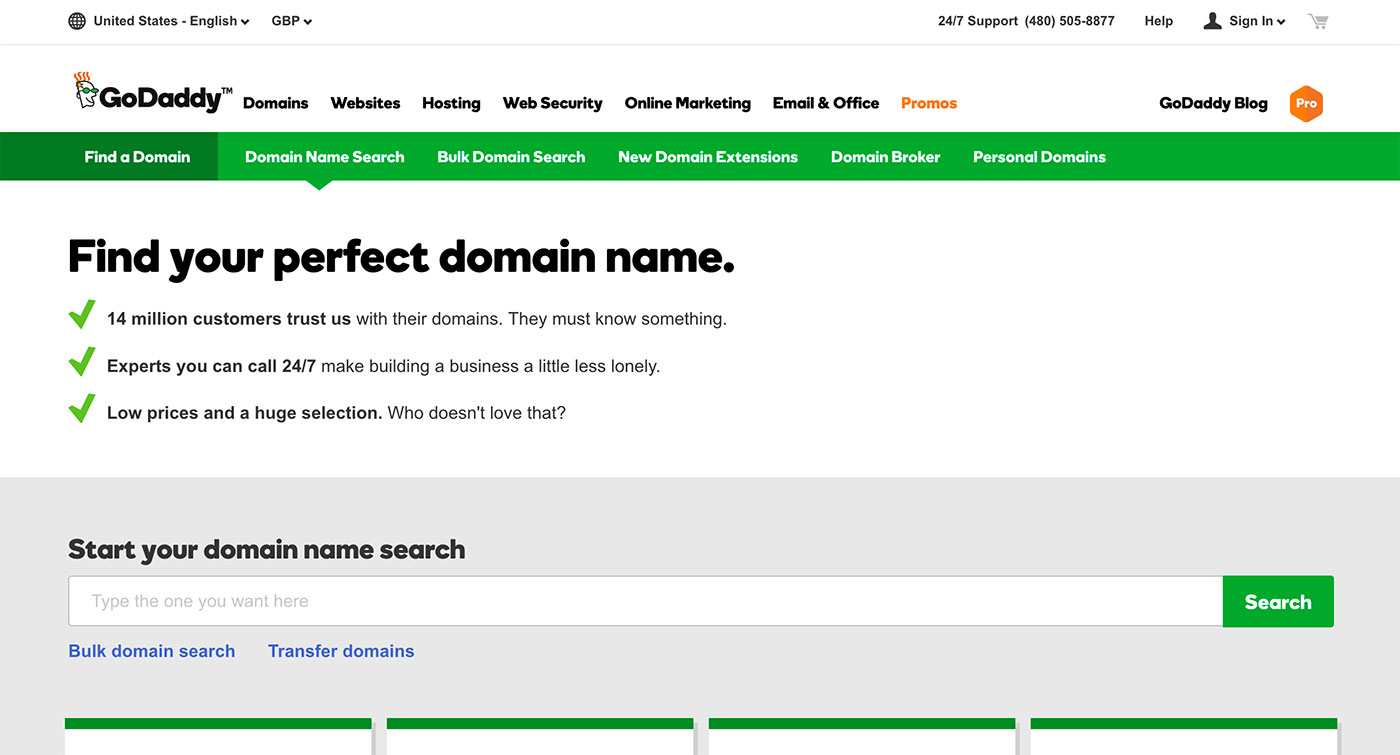
Your hosting company may offer domain registration. Having everything in one place makes setup easier, but make sure you can change the MX records, WhoisGuard is offered, and two-step verification is possible (we’ll explain what these are later on -- for now, you just need to know it’s possible). These are the features you need to ensure your domain is safe and there’s no hassle if you decide to change hosts later on.
If you’re expecting your site to grow rapidly, and anticipate needing to change hosts, it’ll be best to keep your domain registration and hosting separate. If, however, you’re expecting to stay with your host for a long time, registering all in one place with a reputable hosting company will be fine.
Once you know where you want to register your domain, it’s just a case of entering the desired domain onto the registrar’s website and following the prompts through the checkout process.
During the checkout process, you’ll be asked for WHOIS information. This is stored by ICANN, the effective police force of all domain registrations, and, by default, is publicly available. You’ll be asked to provide names and addresses for 'registrant', 'billing' and 'admin'. You can enter the same name and address for all of these, but ensure these are accurate: If ICANN attempt to contact you and do not receive a response, they have the power to suspend or cancel your domain.
Understandably, many people don’t want their name and address listed publicly on the internet, so you may wish to purchase WhoisGuard, a service that hides your name and address from the public registries but ensures you’re still contactable if needed. Your domain registrar should offer you WhoisGuard during the checkout process. This is the only extra worth considering -- you can safely ignore all the other add-ons offered when making your purchase.
Once you’re through the checkout, add your billing information, double check the spelling and extension of the domain name, and purchase. You’re now the proud owner of a great domain name for your website!
Purchasing a Great Domain Name Somebody Else Owns
If you do decide you want to purchase a domain name somebody else already owns, and are prepared to undertake the time and financials required, there are some useful tools and tips that can help.

You need to start by doing some research. Find out:
- who owns the domain name
- whether the website is in use
- whether the domain is already for sale.
You should be able to find out who owns the domain name by searching for the registered owner at the public domain database. This should reveal the name of the owner, their address and a contact email address. Some websites will have 'WHOISGUARD PROTECTED' listed as the register, which will hide the name and address of the owner, but you’ll still be able to use the email address to contact the owner.
Next, find out if the website is in use by visiting it. If the website is already in use, this both decreases the likelihood the owner will be willing to sell, and will likely increases the price as well. If the domain is unused, the owner will likely be open to the possibility of a sale, and if visiting the domain tells you it’s for sale you’re in luck. You should also conduct a search on GoDaddy’s domain auction site, Sedo and Flippa to find out if the domain is for sale, but doesn't have this information listed on the site.
You now have three options on how to proceed:
- attempt to purchase the domain privately
- use a domain purchasing service
- purchase through a marketplace.
Purchasing a domain privately is the riskiest option, and involves emailing the owner using the details you looked up earlier. You’re on your own when dealing directly via email -- you won’t receive any third-party guarantees or protections, as you would on an auction site -- but you may be able to strike a better deal this way. Be careful not to disclose your personal info, as when emailing any stranger. If the owner can find out about you or your business, this gives them valuable information for negotiating. You may, for example, find the price doubles if you’re a competitor.
As in any negotiation, always begin by putting the ball in their court: 'What do you think is a fair price?' If they ask you straight-out to make an initial offer, go the lowball route, offering about half of the price you’re actually willing to pay. Always haggle, and never accept the first offer you get.
When it comes to payment, you'll want to use a service such as Escrow, which will hold payment securely until you can verify the domain has been safely transferred: This avoids a lot of the risk of being scammed.
A domain purchasing service makes things easier and removes some of the risk, but will cost you more. GoDaddy offers a domain brokerage service that charges an upfront fee plus 20% of the purchasing cost. A service such as GoDaddy’s offers protection and guarantees your anonymity, but can be expensive, and there’s no guarantee it will succeed.
If your chosen domain is already for sale, you’re in luck, but there’s still a lot of work to do. Use the same valuation and negotiating tactics as you would with a private purchase (see above). Most marketplaces or auction sites will offer buyer protection, which will ensure you actually get your domain, but your bargaining position will be greatly weakened if there are other potential buyers, driving the price up. It’s very important to be aware of these costs before you start.
When purchasing a domain, part of the purchasing process will be transferring the domain to your own registrar so you can take ownership. The process for this is very similar to registering a domain for the first time (see above), except you’ll need to transfer the domain rather than register from scratch. The same companies recommended above for registering a domain will also let you transfer a domain.
Purchasing a domain someone else has already registered is expensive and, in most cases, the better option is to find a different name. If you absolutely must have a domain someone else has already registered, however, it's possible to purchase, and the steps listed here will help you through the process.
Safeguarding Your Domain: Protecting Your Brand
Once you’ve registered your new domain or acquired a previously registered domain, don’t close your registrar’s website! There are now a couple of things to do that can safeguard your new domain against administrative problems and cybercrime.
You can run through the bullet points below as a checklist:
- Set your domains to auto-renew: This saves hassle in the future, and means you don’t have to worry about forgetting to renew your domain (just make sure the expiration date on your credit card is far enough into the future).
- Set up two-step verification: domain hijacking is a very real problem. If someone hacks your account and steals your domain name, it’s exceptionally difficult to get it back. Avoid this unfortunate scenario by using a strong password and enabling two-step verification, a security feature that requires a second code to access your account -- normally sent to your phone.
- Lock your domain: Similarly, make sure your domain is locked and can't be transferred. This will further mitigate the risk of hijacking. Your registrar’s helpdesk should provide details on how to do this.
- Secure social usernames: Earlier, we recommended using Namechck to see which social media sites had username availability for your domain. Now, go out and secure them! Register accounts if you're not planning on using them for now.
- Purchase alternative extensions: What would happen if a competitor purchased the
.org,.netor.co.ukextension of your domain? This would almost certainly be a very bad scenario (Apple, for example, didn’t ownapple.co.ukfor 16 years), and it’s easily mitigated by purchasing the main extensions for your name. - If your domain is easily misspelled, purchase the misspellings: If you can spot an easy way your domain could be misspelled, purchase that domain as well and redirect it to your main domain (remember Flickr having to buy
flicker.com?). You don’t want a common misspelling of your site to end up in the wrong hands.
These are all straightforward things to do, but don’t let that make you think they’re not important: The consequences of not doing any one of these items is potentially very bad indeed. Save hassle and problems later on by safeguarding your domain right away.
Setting up Your Domain: Connecting to Your Hosting
Remember the technical explanation of domain names -- that they're used to identify one or more IP addresses, and these typically host websites? This means each domain needs to know which IP address to point to. This is all the setup that's required for a domain name: You just need to tell it how to point to your hosting. This is remarkably easy, and will only take a couple of minutes.
If you’ve purchased your domain through your hosting provider, you should have everything set up automatically and can skip this section.
You need to tell your hosting provider that you have new domain. If this is your first domain, then your host should guide you through this process as you purchase hosting. If you already have hosting and a domain, you’ll need to add the new domain as an add-on domain.
Most hosts use a control panel system, called cPanel, which makes it easy for you to do this. Your host will be able to tell you in their support section whether they use cPanel; if they don’t, search for how to add an add-on domain, and you should find clear instructions.
Log in to cPanel and look for 'Addon Domains'. You now just need to enter your new domain name and press 'Add Domain'.
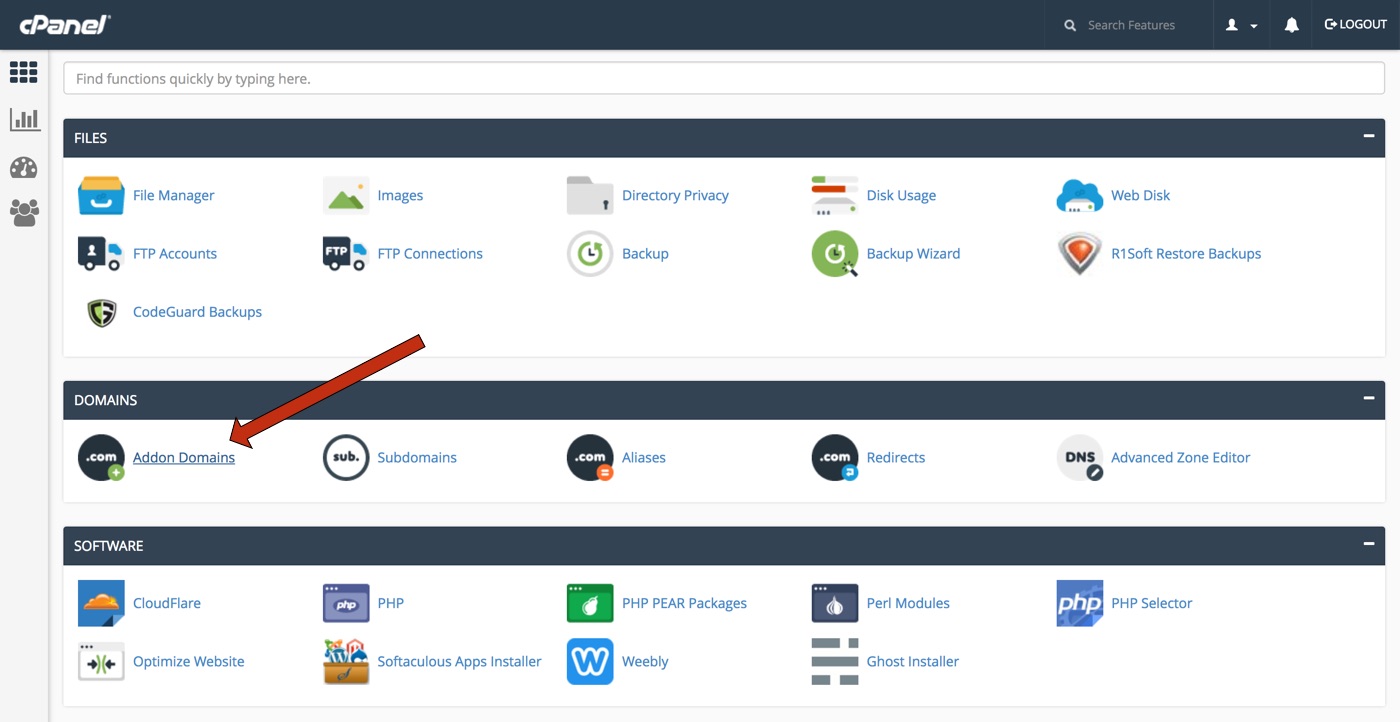
Now that your hosting provider is expecting to receive your domain name, you need to find out where to point your name, which involves finding your host’s nameservers. You can do this by searching for host name + nameservers. Some of the most common hosts’ nameservers are listed below:
- WP Engine: Can be found here.
- MediaTemple: NS1.MEDIATEMPLE.NET and NS2.MEDIATEMPLE.NET.
- DreamHost: ns1.dreamhost.com, ns2.dreamhost.com and ns3.dreamhost.com.
- Bluehost: ns1.bluehost.com and ns2.bluehost.com.
Now, head to your registrar’s administrator panel, look for options to manage your domain and then find nameservers. If you’re struggling to find the right options, a search for how do I change nameservers on host's name will bring you information about your specific host.

Once you’ve found the options, you’ll want to set nameservers to 'custom', and then enter the nameservers for your host (possibly listed above). Save your changes, and you’re done!
The setup is complete, but you’ll need to wait for up to 48 hours for the settings to propagate across the globe. Once this has happened, your website will be accessible by visiting your domain name.
You will, of course, also need to set up hosting and install WordPress if desired, but that’s for another guide...
Final Thoughts
Hopefully, you now have a brilliant new domain chosen, purchased and set up for your site. Congratulations! This can be a difficult process, but it’s well worth spending the time on it as your domain name really embodies your site’s whole identity -- and is something that'll hopefully be with you for a very long time!

Good luck!
Choosing a domain name isn't easy — and it may take you a while until you find an idea that really clicks with you and is also still actually available for purchase. Whatever you do, don't be put off or discouraged if you don't find something that suits straight away though, because, with enough effort, sooner or later you'll hit upon a winner!



